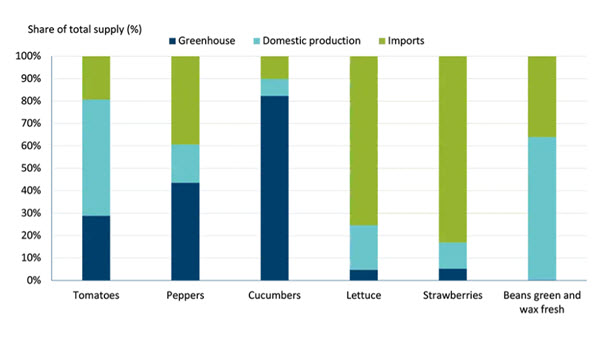Controlled Environment Agriculture Farming Growing Strong Roots in Canada
According to a report by FCC, Canada has become more self-sufficient in greenhouse-grown crops like cucumbers, peppers, tomatoes, and mushrooms. Between 2013 and 2023, it shifted from being a net importer to a net exporter for several of these, thanks to controlled environment agriculture (CEA).
With many Canadians currently looking at the country becoming more self-sufficient, is this truly an area for growth?
Greenhouses offer protection from unpredictable climates and allow year-round production. Strawberry greenhouse farming, once negligible, reached 16.5 million pounds in 2024. More operations have also emerged outside Ontario, the traditional greenhouse hub, showing the potential for nationwide expansion.
Figure 2 Origin of Selected Canadian Fruits and Vegetables
 Source: Statistics Canada, FCC Economics
Source: Statistics Canada, FCC Economics
Figure 2 reveals that while greenhouse cucumbers make up a large part of the total supply, others like beans remain mostly imported. This highlights an opportunity for growth. FCC believes Canada can still increase local production of lettuce, herbs, and strawberries to meet national demand.
Threat: High costs and limited workforce
Despite the benefits, greenhouse farming faces high startup costs for land, equipment, and technology. Operating costs have risen by 6% yearly, although sales are slightly higher at 6.4%, helping maintain slim profit margins.
A major threat is the shrinking younger workforce. FCC data shows greenhouse labour under age 60 has dropped 8% yearly, with only 4.2 younger replacements per retiree. Infrastructure limitations like energy and water access also restrict expansion.
Greenhouse farming offers a path to reduce reliance on imports. However, addressing rising costs, labour shortages, and crop limitations will be essential for scaling up Canada’s CEA potential says FCC.